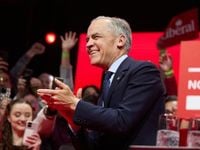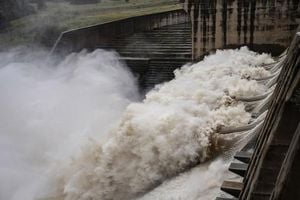Canada’s governing Liberal Party, led by Prime Minister Mark Carney, has won the national elections for a fourth term, marking a remarkable comeback fueled partly by unprecedented attacks from United States President Donald Trump. The election, held on April 28, 2025, saw millions of Canadians cast their votes in a snap election, where the dominant question was: which candidate could better handle Trump’s threats of tariffs and annexation?
As the results rolled in, national broadcaster CBC projected that by 10:00 PM EDT on April 29, 2025 (02:00 GMT on April 30), the Liberal Party was on track to secure a sufficient number of seats in the House of Commons to form a government. Voting was conducted for the 343-member House of Commons, with a party needing to win at least 172 seats to achieve a majority.
Preliminary results indicated that the Liberals had won or were leading in 168 seats, while the Conservative Party, led by Pierre Poilievre, had secured or was leading in 144 seats. The Bloc Quebecois, a regional party, was projected to win 23 seats, while the left-leaning New Democratic Party (NDP) managed to secure only 7 seats. The Green Party won one seat.
Comparing these results to previous elections, the Liberals had won 160 seats in 2021 and 157 in 2019. The Conservatives had garnered 119 seats in 2021 and 121 in 2019, and the NDP had won 25 seats in 2021 down from 24 in 2019. The current election saw a slight increase in the total number of seats from 338 to 343.
One of the defining issues of this election was Trump's threats of tariffs and annexation, which were significant factors influencing voter sentiment. Trump had imposed a 25 percent tariff on Canadian products and a 10 percent tariff on Canadian energy, arguing that Canada was not doing enough to prevent irregular migration and drug trafficking into the U.S. He even suggested in a February interview that "Canada would be much better off being a 51st state." This rhetoric resonated deeply in Canadian political discourse, with experts noting that Trump’s influence was a major factor in the election.
Daniel Beland, a professor at McGill University, remarked, "The most important factor in Canadian politics right now doesn’t live in Canada – it’s Donald Trump." The cost of living crisis, particularly the rising prices of groceries and housing, also played a critical role in shaping the election. Under former Prime Minister Justin Trudeau, inflation had surged to 8.1 percent in June 2022, the highest increase since 1983, leading to widespread dissatisfaction among voters. Trudeau, who had been in office since 2015, stepped down on March 9, 2025, after facing increasing pressure.
Despite a challenging landscape, the Liberals managed to regain ground in the polls starting in February 2025, aided by the backlash against Trump’s comments. Philippe J. Fournier, an analyst and creator of the electoral projection model and website 338Canada, noted, "In Canadian polling history, at least in this century, it is the first time I’ve ever seen this. To come back from a 25-point deficit is very unheard of, especially for a government that’s been in power for almost a decade."
Carney, who took over leadership of the Liberals after Trudeau's resignation, campaigned on a platform promising to address the cost-of-living crisis, counter Trump’s tariffs, and protect Canadian workers. During an English language debate on April 18, he stated, "I am ready and I have managed crises over the years … We will fight back with counter-tariffs and we will protect our workers." His campaign was characterized by a strong response to Trump’s rhetoric, positioning him as a capable leader in uncertain times.
Meanwhile, the election results marked a significant collapse for the NDP. Jagmeet Singh, the party leader, announced he would be stepping down after the NDP was projected to lose official party status in the House, as they fell short of the 12 seats required for that designation. Singh himself lost his seat in Burnaby Central, British Columbia, finishing in third place. He acknowledged the disappointing results, stating, "We’re only defeated when we believe those that tell us that we can never dream of a better Canada, a fairer Canada, a more compassionate Canada."
In a surprising turn, Conservative leader Poilievre was projected to lose his long-held seat in Carleton, Ontario, to Liberal candidate Bruce Fanjoy. Poilievre had been elected in Carleton since 2004. Despite this setback, he congratulated Carney on his victory and emphasized the need for collaboration among parties to counter Trump’s threats, stating, "Conservatives will work with the prime minister and all parties with the common goal of defending Canada’s interests and getting a new trade deal that puts these tariffs behind us while protecting our sovereignty."
As the dust settles on the election, the composition of the House of Commons is set to change significantly. Carney will now work to form a government, but whether it will be a minority or majority remains uncertain. If the Liberals secure a majority, Carney would proceed to assemble a cabinet and work on a budget plan before the House reconvenes on May 26, 2025. However, if they fall short, they may need to negotiate with other parties to pass legislation and avoid no-confidence votes.
Political analysts suggest that Carney's government will likely seek to engage with other party leaders to establish a stable coalition, especially given the current geopolitical climate and the challenges posed by Trump’s administration. “A loss of confidence vote in the House of Commons would prompt another election,” warned Tari Ajadi, an assistant professor at McGill University.
As Canadians reflect on the election’s outcome, it’s clear that the political landscape has shifted dramatically, with the Liberal Party emerging as a key player in navigating the challenges ahead in a time of uncertainty.





